check engine light AUDI S6 2010 Owner's Manual
[x] Cancel search | Manufacturer: AUDI, Model Year: 2010, Model line: S6, Model: AUDI S6 2010Pages: 368, PDF Size: 86.82 MB
Page 244 of 368

Intelligent technology
'-----------------------------------------------
Driv ing off
When driving off, always be sure to keep road conditions in mind as
you acce lerate. If one d rive w heel spins because it is on a surface with
less grip, gradua lly inc rease the press ure on the accelerator pedal
un til the car sta rts to move .
Overheating of brakes
To prevent the disc brake of the braked wheel from overheating if
subjected to excessive loads o n this whee l, t he EDL cuts out tem po
ra rily. The vehicle rema ins operat iona l a nd be haves in the same way
as a ve hicle wit hout EDL.
As soon as the bra ke has coo le d down , ED L swit ches on again au to
matically.
& WARNING
• When accelerating on slippery surfaces , such as on i ce or snow ,
alway s be careful when depre ssing the accelerator pedal. Even
with the EDL work ing , the drive wheels can spin and reduce your
ability to control your car. Risk of crash!
• The increased safety afforded by EDL does not mean that you
can take safety ri sks . Always adapt your driving style to the road
conditions and traffic situation.
(I) Tips
If a fa ult occurs i n the ABS, the EDL is also not f unct io ni ng . This is
indic ated by t he A BS war ning ligh t=>
page 17.
Anti-Slip Regulation System (ASR)
The Anti- S lip Re gula tio n Sy stem preven ts the dr iven
w heels from spin ning w hen t he car is accelerating .
General notes
The Anti-S lip Reg ulation Sys tem (AS R) is in tegr ate d in the ele ctroni c
stabilization program (ESP) . When the ve hicle starts up and acceler
at es, the whee ls are p reven ted from sp inning by adjust ing t he engine
power to match the amount of grip avai lable from the road surface.
How the system works
ASR performs automatically, i.e. witho ut the driver 's intervent ion.
W ith the a id of t he ABS sensors=>
page 244, ASR moni to rs the speed
of the dr iven wheels. If the wheels start to spin , th e engine torque is
redu ced a utomatically unti l the t ires find enou gh gr ip to lock onto
the road surface. T he system is active across the entire speed range .
Th e ASR works in conjunction with the ABS. If a malfunction sho uld
occ ur in th e ABS, th e AS R w ill also be out of action.
Activating
The ESP is automatically activated whe n the engine is started and it
performs a se lf-test. You can act ivate a deact ivate d ASR if required by
press ing the=>
pag e 240, fig. 201 button. Whe n it is act ivated, t he
message
ESP/ASR on appears briefly in t he disp lay. Vehicles with
front-wheel d rive a dea ct iva te d ASR a uto mat icall y re-ac tiva tes i tself
at a speed of 40 mp h (70 km/h) .
Deactivating
You can deact ivate t he ASR if required by pressing t he button (for less
t han 3 se conds) =>
page 240, fig. 2 0 1. Wi th the ASR dea ct ivated, the
ESP check light comes on, see=>
page 14. The message ASR off
appe ars i n the di sp la y as wel l. On vehicles wi th fro nt-whee l dr ive:
deactivation is possible only up to 30 mph (SO km/h) for safety
reas ons. Vehi cles w ith all -w heel drive: the AS R can be deac tivated at
any speed. ..
Page 247 of 368

Intelligent technology
--------------------------------------------------' '----'----
these circ umstances, it is especially importa nt that you dr ive slowly
a nd wi th grea t ca re .
How the ABS system works
An au tom ati c c heck is m ade w hen a speed of about 4 mp h (6 km /h) is
reac hed. When th is happens, a pump ing no ise can be heard.
If an indivi dual w heel beg ins to rot ate too s low ly in relat ion to vehi cle
speed and tends to lock, t he A BS a utomat ically reduces brake pres
sure to prevent that w heel from loc king .
Thi s au tom atic adju stm ent pr oces s w ill c au se a
slight vibration of
the brake pedal and some noises to alert you that vehicle speed must
be ad apted to exis tin g road and traff ic c ondi tio ns.
& WARNING
Although the ABS is very effective, always remember that braking
capability is limited by tire traction. Always adjust your driving
speed according to the road and traffic conditions. Do not let the
extra safety afforded by the ABS tempt you into taking extra risks.
The ABS cannot overcome the laws of physics.
[ i J Tips
• If A BS is no t fu nct ion ing prope rly, a w arn ing ligh t will come on .
See
~ page 17 .
• If a f ault o ccur s in the A BS, the EDL is also not func tio ning. T his is
ind icated by the ABS war ning light.
Brake assistant
--
The brake assis tan t is d esign ed to achie ve the opt imum
b raki ng eff ect.
The b rake ass istant he lps to increase the effective braking power and
t hu s to ac hi eve a shorter stopping dis tance . If t he dr iver p re sse s t he
brake peda l ve ry qu ickly, the b rake assistant automatica lly boosts the
Controls and equip
ment Safety first Vehicle operation
brak
ing fo rce to t he maximum level , up to the point where the anti
l ock brak e fu nction (A BS) in terve nes to stop the whee ls fr om l ocking.
Yo u should t hen kee p the brake pedal pressed unti l the ve hicle has
bra ked to the required speed. The bra ke ass istant switches itself off
as soon as you re lease the brake pedal.
The brake assistant will not be operative i f th ere is a ma lf u nction in
t he A BS.
& WARNING
Please remember that the accident risk always increases if you
drive too fast, especially in corners or on a slippery road , or if you
follow the vehicle ahead of you too clo sely. Increa sed risk of an
accident cannot be compensated for even by the brake assistant ,
so always maintain a safe speed .•
Servotronic® - advanced power
steering system
The po wer s teerin g sys tems uses the power of the
runnin g engine to a llow p re cis e st ee rin g with little effort.
The adva nced Servotronic ® power stee ring syste m senses the road
speed and elect ronically adjusts power assistance to p rovide
c omfortab le and saf e steer ing response exa ctly match ed to th e
vehicle speed.
P owe r steer ing will not wor k if the engine is o ff. As a resul t, the
steeri ng wheel will be hard to tu rn .
The power steering fluid level is checke d dur ing the sched uled main
tenance se rvices .
0 Note
If the re is a n ele ct ronic mal func tion, s ervo tr onic will s till f unction
like a conventional power steering system, provid ing a constant
~
Vehicle care Do-it-yourself service Technical data
Page 250 of 368
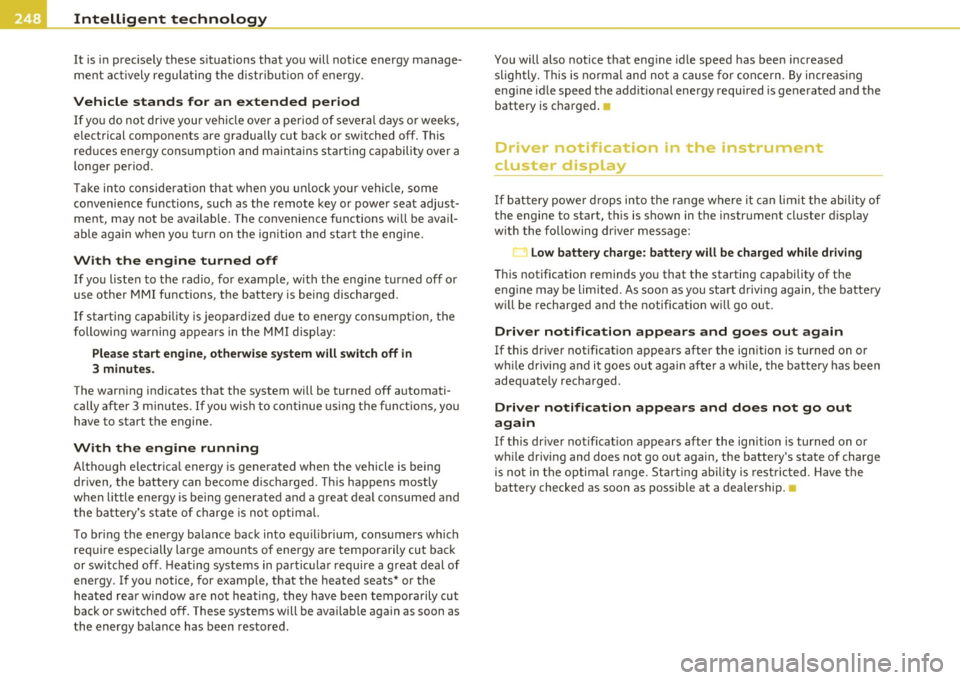
Intelligent technology
'-------------------------------------------------
It is in precisely these situations that you will notice energy manage
ment actively regulating the distribution of energy.
Vehicle stands for an extended period
If you do not drive your vehicle over a period of several days or weeks,
electrical components are gradually cut back or switched off. This
red uces energy consumption and maintains starting capability over a
longer period.
Take into consideration that when you unlock your vehicle, some
convenience functions, such as the remote key or power seat adjust
ment, may not be avai lab le. The convenience functions wi ll be ava il
able again when you turn on the ignition and start the engine.
With the engine turned off
If you listen to the radio, for example, with the engine turned off o r
use other MMI functions, the battery is being discharged.
If starting capability is jeopard ized due to energy consumption, the
following warning appears in the MMI display:
Please start engine, otherwise system will switch off in
3 minutes .
The warning indicates that the system will be turned off automati
cally after 3 minutes. If you wis h to continue using the funct ions, you
have to start the engine.
With the engine running
Although electrica l energy is generated when the vehicle is being
dr iven, the battery can become discharged. This happens mostly
when little energy is being generated and a great deal consumed and
the battery's state of charge is not optimal.
To bring the energy balance back into equilibrium, consumers which
req uire especially large amounts of energy are temporarily cut back
or switched off . H eating systems in particular require a great deal of
energy. If you notice, for example, that the heated seats* or the
heated rear window are not heating, they have been temporarily cut
back or switched off. These systems will be ava ilable again as soon as
the energy ba lance has been restored. You will also
notice that engine idle speed has been increased
slightly. This is normal and not a cause for concern. By increasing
engine idle speed the addit ional energy required is generated and the
battery is charged. •
Driver notification in the instrument
cluster display
If battery powe r drops into the range where it can limit the ability of
the engine to start, this is shown in the instrument cluster display
w ith the following driver message:
1 Low battery charge: battery will be charged while driving
This notification reminds you that the starting capability of the
eng ine may be limited. As soon as you start driving again, the battery
will be recharged and the notification will go out.
Driver notification appears and goes out again
If this driver notification appears after the ignition is turned on or
wh ile driving and it goes out again after a while, the battery has been
adequately recharged.
Driver notification appears and does not go out
again
If this dr iver not ificat ion appears after the ign it ion is turned on or
whi le driving and does not go out again, the battery's state of charge
is not in the optimal range. Starting ability is restricted . Have the
battery checked as soon as possible at a dealership.
Page 254 of 368
![AUDI S6 2010 Owners Manual Driving and environment
(I] Tip s
The consumption estimates as pub lished by ENV IRONMENTAL
PROTECTION AGENCY (EPA) and Transport Canada may not corre
spond to your actual consump AUDI S6 2010 Owners Manual Driving and environment
(I] Tip s
The consumption estimates as pub lished by ENV IRONMENTAL
PROTECTION AGENCY (EPA) and Transport Canada may not corre
spond to your actual consump](/img/6/57594/w960_57594-253.png)
Driving and environment
(I] Tip s
The consumption estimates as pub lished by ENV IRONMENTAL
PROTECTION AGENCY (EPA) and Transport Canada may not corre
spond to your actual consumption on the road, which will vary
depending upon vehicle load and speed, road and weather conditions,
trip length, etc. •
Drive smoothly and keep a lookout ahead
Vehicles use the most fuel when they are accelerating .
-Avo id unnecessary accelerating and braking.
Vehicles use the most fue l when they a re accele rating. If you antici
pate what is going to happen next, you will need to brake less and,
thus, accelerate less. Let the vehicle coast whenever possible -for
example when you see that the next traffic l ight is red. •
Avoid full throttle
Driving at moderate speeds saves fuel and improves your
mileage.
- Try and keep well below your car's maximum speed .
Accelerating gently reduces fuel consumption, engine wear, and does
not disturb the environment.
Fuel consumption, exhaust emissions and engine noise increase
disproportionately at high speeds . If you drive at approx imately three
qua rters of top speed, fuel consumption will be reduced by one half.
Never drive faster than the posted speed limit and weather condi
tions permit.
a Reducing unnecessary idling
Even when your car is just idling it burns up fuel.
-
Shut the engine off when yo u are not driving the vehicle.
- Do not warm up the vehic le by letting the eng ine run at
idle.
It makes sense to shut off the engine in traffic jams, when waiting for
trains to pass at rai lroad crossings, o r at traffic lights that have long
wa its on red . Turn ing the eng ine off for just 30-40 seconds saves
more fuel than is burned starting the engine again.
It takes a long t ime for the engine to warm up fully when it is running
at idle. Howeve r, wear and noxious emissions are espec ially high
when the eng ine is wa rm ing up. So you sho uld d rive away as soon as
you start the engine and avoid running at hig h rpms while the eng ine
is still warming up.
0 Note
Do not leave engine idling unattended after starting . If warning
lights should come on to indicate improper operation, they would go
unheeded. Extended idling also produces heat, which cou ld result in
overheat ing o r othe r damage to the vehicle or other p roperty. •
Regular maintenanc_e ____________ _
A badly tuned engine unnecessarily wastes a lot of fuel .
- Have your vehicle serviced at regular intervals .
By having yo ur vehicle regularly se rviced by an Audi dealer helps to
ensure that it runs properly and economically . T he condition of your
vehicle not only a ffects its safety and ability to ho ld its va lue, it a lso
affects
fu el con sumption .
Check your o il e ach tim e you fill you r tank.
~
Page 278 of 368
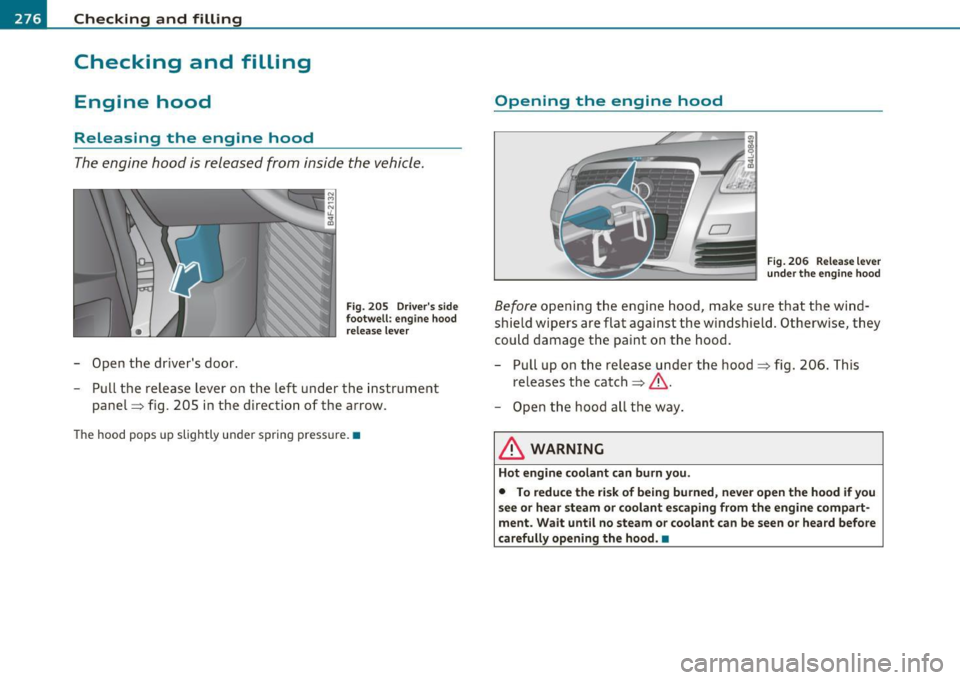
lffll __ C_h_ e_c _k _i_n -=g :a,__ a_n_ d_ f_ i_ l _li _n _,g;._ __________________________________________ _
Checking and filling
Engine hood
Releasing the engine hood
The engine hood is released from inside the vehicle.
-Open the driver's door.
Fig. 205 Driver's side
footwell: engine hood
release lever
- Pull the release lever on the left under the instrument
panel => fig. 205 in the direction of the arrow.
The hood pops up slightly under spring pressure. •
Opening the engine hood
Fig. 206 Release lever
under the engine hood
Before opening the engine hood, make sure that the wind
shield wipers are flat against the windshield. Otherwise, they
could damage the paint on the hood.
Pull up on the release under the hood=> fig. 206. This
releases the catch =>
&.
- Open the hood all the way.
& WARNING
Hot engine coolant can burn you.
• To reduce the risk of being burned, never open the hood if you
see or hear steam or coolant escaping from the engine compart
ment. Wait until no steam or coolant can be seen or heard before
carefully opening the hood. •
Page 282 of 368
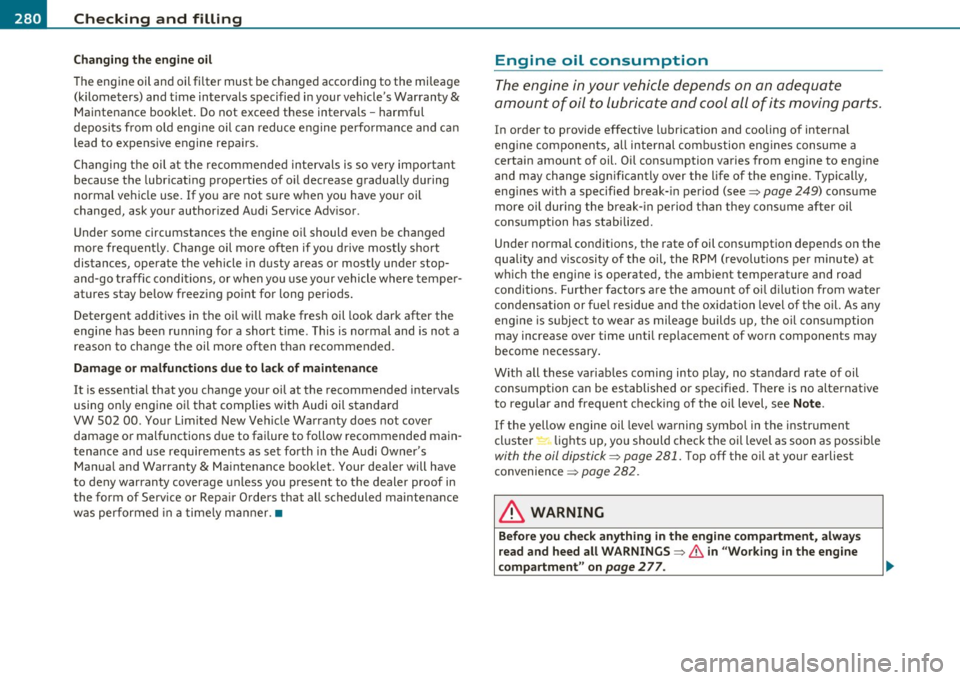
___ C_ h_e _c_ k_ i_ n _ g_ a_ n _ d_ f_il _l _in ____ g ___________________________________________ _
Changing the engine oil
The engine oil and oil fi lter must be changed according to the mileage
(kilometers) and t ime intervals specified in your vehicle 's Warranty
&
Maintenance booklet . Do not exceed these interva ls -harmful
deposits from o ld engine oil can reduce engine performance and can
lead to expensive engine repairs .
Changing the oil at the recommended intervals is so very impo rtant
because the lubricating properties of o il decrease gradually during
normal vehicle use. If you are not sure when you have your oil
changed, ask your author ized Audi Service Adv isor .
Under some circumstances the engine oil should even be changed
mo re frequently. Change oil more often if you drive mostly short
distances, operate the vehicle in dusty areas or mostly under stop
and-go traffic conditions, or when you use your vehicle where temper
atures stay be low freezing point for long periods.
Detergent addit ives in the oi l wi ll make fresh oil look dark after the
engine has been running for a short t ime. This is normal and is not a
reason to change the oil more often than recommended .
Damage or malfunctions due to lack of maintenance
It is essential that you change your oil at the recommended intervals
using only engine oi l that complies with Audi oil standard
VW 502 00. Your Limited New Vehicle War ranty does not cover
damage or malfunctions due to fai lure to follow recommended main
tenance and use requirements as set forth in the Audi Owner 's
Manual and Warranty
& Maintenance booklet. Your dealer will have
to deny warranty coverage unless you present to the dealer proof in
the form of Serv ice or Repair Orders that all scheduled maintenance
was performed in a time ly manner. •
Engine oil consumption
The engine in your vehicle depends on an adequate
amount of oil to lubricate and cool all of its moving parts.
In order to provide effective lubrication and cooling of internal
eng ine components, all inte rnal combustion engines consume a
certain amount of oil. Oil consumption varies from engine to engine
and may change sign ifican tly over the lif e of the engine. Typically,
engines with a specified break- in period (see~
page 249) consume
more oil during the break-in period than they consume after oil
consumption has stab ilized .
Under normal conditions, the rate of oil consumption depends on the
quality and viscosity of the oil, the RPM (revolutions per minute) at
which the engine is operated, the ambient temperature and road
conditions. Further factors are the amount of oil dilution from water
condensation or fuel residue and the ox idation level of the oil. As any
eng ine is subject to wear as mileage builds up, the oil consumption
may increase over time until replacement of worn components may
become necessary.
With all these variab les coming into play, no standard rate of oil
consumption can be established or specified . There is no alternative
to regular and frequent checking of the oil level , see
Note .
If the yellow engine oil leve l warning symbol in the instrument
cl uster lights up, you should chec k the oil level as soon as possible
with the oil dipstick~ page 281. Top off the oil at your earliest
convenience ~
page 282.
& WARNING
Before you check anything in the engine compartment, always
read and heed all WARNINGS~
& in "Working in the engine
compartment" on
page 277.
Page 287 of 368

_____________________________________________ C_h_ e_ c_k _in --= g=--- a_n_ d_ f_ i_ll _i_n __.g=-- -•
Before you c hec k anythi ng in the engine compartment,
alwa ys r ead and heed all WARNINGS==> & in "Working in
the engine compartment" on
page 277.
- Turn off the ignition.
- Read the engine coolant level from the coolant expansion
tank==>
page 284, fig. 211. With a cold engine, the
coolant level should be between the "min" and "max"
markings . When the engine is wa rm, the level may be
sligh tly above the "max" marking .
The locat io n of the coolant expansion tank can be seen in the engine
compartment ill ustration ~
page 278.
To obta in an accurate reading, the engine must be sw itched off.
The expans ion tank in your vehicle is equ ipped with an electric coolant
level sensor .
When the coolan t level
is too low, the warn ing light in t he Au to-Che ck
System ~
page 2 7 will blink until you add coo lant and the level has
bee n restored to normal. Even though the re is an elect ric coolan t
level sensor, we still recommend you check the coolant leve l from
time to time .
Coolant loss
Coolant loss may ind icate a leak in the cooling system. I n the event of
coo lant loss, the cooling system should be inspected immed iately by
yo ur au tho rized A ud i dea le r.
It is not enough mere ly to add coolant.
In a
s e a le d system, losses can occur only if the bo iling point of the
coo lant is exceeded as a resu lt of overheating .
0 Note
Do not add any type of radiator leak sealant to your vehicle's engine
coo lant. Add ing radiator repa ir fluid may adverse ly affect the func
tion and performance of your cooling system and could result in
damage not covered by your New Vehicle Limited Warra nty. •
Safety first
Adding coolant
Be very careful when adding engine coolant.
B efore you check a nything in t he engine compartment,
always read and heed all WARNINGS==> & in "Working in
the engine compartment" on
page 2 77.
- Turn off the engine.
- Let the engine cool down .
- Place a th ick rag over the coolant expansion tank
==>
page 284 , fig. 211 and carefully twist t he cap counter
clockw ise ==>& .
- Add coolant .
- Twist the cap on again
tightly .
Replacement eng ine coolant must conform to exact spec ifications
~ page 284, "Coolant". Even in an emergency, if coolant additive
G 12++, G12+ or G12 is not available, do
not use a different addi tive .
Use plain water instead until you can get the correct additive and can
restore the correc t ratio. This should be done as soon as possible.
If you have lost a considerable amount of coolant, then you should
add co ld antifreeze and cold water only when the eng ine is co ld .
Always use
new engine coo lant w hen refilling.
Do not fill coolant above the "MAX" mark. Excess coolant will be
forced ou t th rough the p ress ure relief v alve in the cap when the
engine becomes hot .
& WARNING
• The cooling sy stem i s under pres su re a nd can get very hot.
Reduc e the ri sk of scalding from hot coolant by following the se
steps.
-Tu rn off the engine and allow it to co ol d own . _,.
Vehicle care Technical data
Page 289 of 368
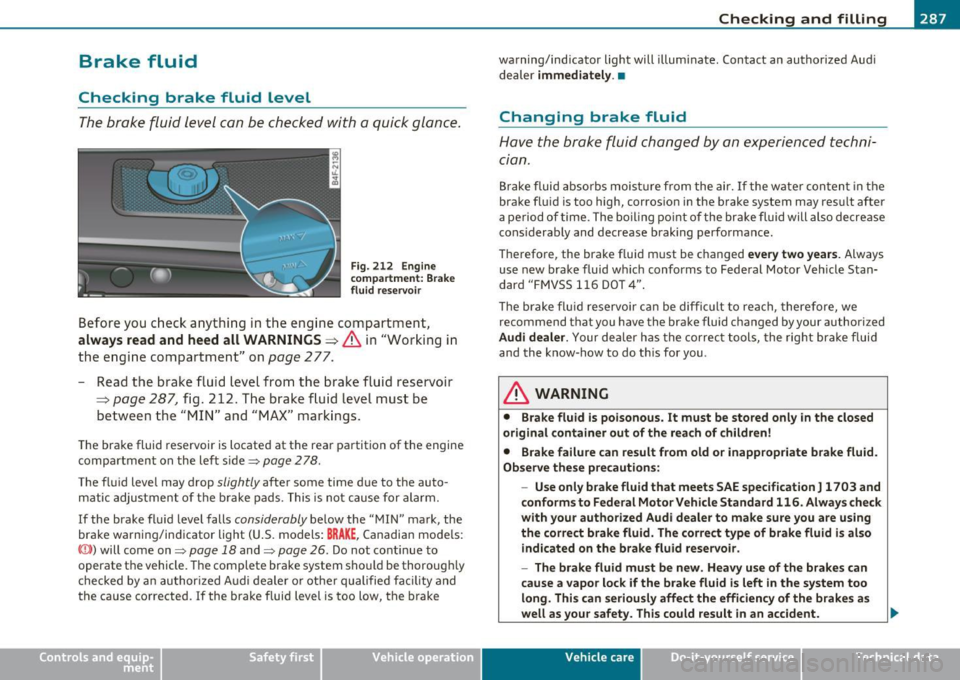
___________________________________________ C_ h _ e_c _k _ i_n -=g .._ a_n _ d_ f_i _ll _i _ n -=g '--- ........ 11'1
Brake fluid
Checking brake fluid level
The b rake f lu id l eve l can be checke d wit h a qui ck g lanc e.
Fig . 212 E ngine
compartment : Br ake
fluid re se rv o ir
Before you c heck a nythi ng in the eng ine compartment ,
always read and heed all WARNINGS~ & in "Working in
the e ngi ne comp art ment" on
page 27 7.
- Read t he bra ke flu id level from the bra ke fluid reservoir
~ page 287, fig . 212. The brake flu id level must be
between the " MIN" and " MAX" mar kings.
The brake fluid reservoir is locate d at the rear pa rtition of the engine
compartmen t on the left s ide=>
page 278 .
The f luid leve l may drop slightly after some time d ue to the auto
m atic a dju stment of t he b rake pads. This i s not c ause for ala rm.
If the brake flu id level falls
considerably be low the "M IN" mark, the
brake warni ng/ind icator light ( U.S. models :
BRAKE, Canadia n mo dels:
(0) ) will come on=> page 18 and=> page 26. Do not continue to
operate t he vehicle. The complete brake system sho uld be thoroug hly
chec ked by an au thor ized A ud i d eale r or othe r qualified fac ility and
the cause corrected.
If the brake fluid level is too low, the brake
Vehicle OP-eration
warning/ind icator light will illum inate . Contact an au thoriz ed Aud i
de aler
immediately .•
Changing brake fluid
H av e the b rake fluid chang ed by an expe rie nc ed t echni
CJ an.
B ra ke flui d absorb s moi stur e from the air. If the wa te r co nten t in t he
brake fl uid is too high, corros ion in the b rake system may res ult after
a pe riod of time. The boili ng po int of the brak e flu id will als o decrea se
co nsiderab ly and decrease brak ing perfo rmance.
Th erefore, the brake f lui d m ust be c hanged
every two years . Always
use new brake fluid w hich conforms to Fede ral Motor Veh icle Stan
dard "F MVSS 1 16 DOT 4" .
Th e br ake f luid reserv oir can be diffi cult to rea ch, there fore, we
recommend that you have the brake fluid changed by your authori zed
Audi dealer . Your deal er h as th e correc t tools, the rig ht bra ke flui d
and the know-how to do th is for you.
& WARNING
• Brake fluid is poisonous. It must be stored only in the closed
original container out of the rea ch of children!
• Brake
failure can result from old or inappropriate brake fluid .
Observe these precaution s:
- Use only b rake fluid that meets SAE specification
J 1703 and
conforms to Federa l Motor Vehicle Standard 116. Always check
with your authorized Audi dealer to make sure you are using
the correct brake fluid. The corre ct type of brake fluid is also
indicated on the brake fluid rese rvoir.
- The brake fluid must be new . Heavy use of the brakes can
c ause a vapor lo ck if the brake fluid is left in the system too
long . Thi s can seriously affect the efficiency of the brakes as
well as your safety. This could result in an accident .
~
Vehicle care Do-it-yourselt service Technical data
Page 290 of 368
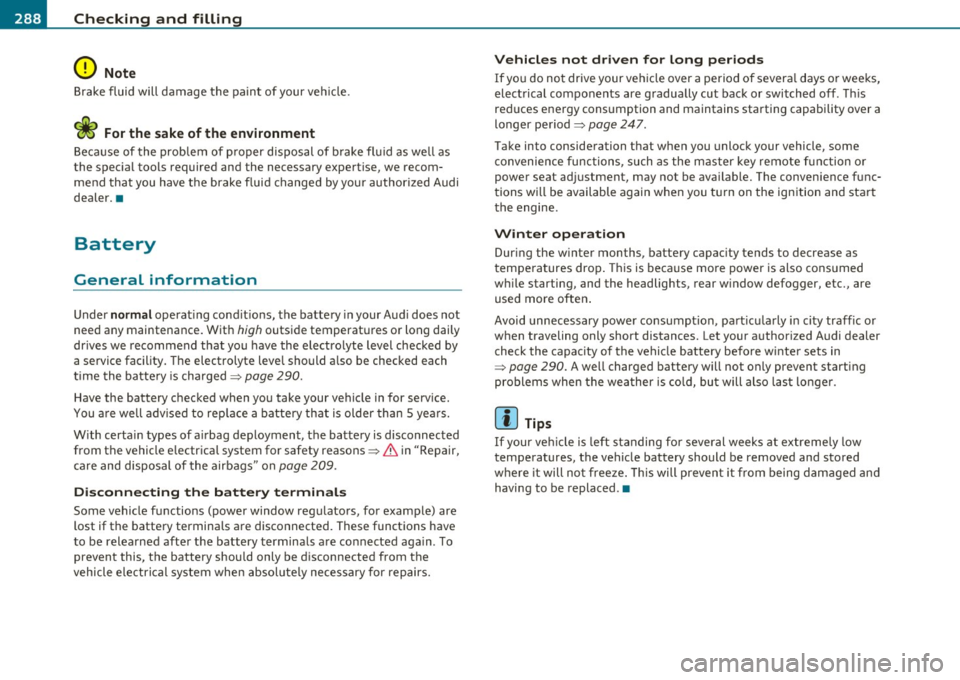
-L~C~ h~ e~c ~k :..!_i ~ n ~g ~ a~n ~d~ f~il ~l~in ~ g[_ ________________________________________ _
0 Note
Brake fluid will damage the paint of your vehicle.
the special tools required and the necessary expertise, we recom
mend that you have the brake fluid changed by your authorized Audi
dealer. •
Battery
General information
Under normal operating condit ions, the battery in your Aud i does not
need any maintenance. With
high outside temperatures or long daily
drives we recommend that you have the electrolyte level checked by
a service facility. The electrolyte level should also be checked each
time the battery is charged~
page 290.
Have the battery checked when you take your vehicle in for service.
You are well advised to replace a battery that is older than 5 years.
With certain types of a irbag deployment, the battery is disconnected
from the vehicle electrical system for safety reasons=>
& in "Repair,
care and disposal of the airbags" on
page 209.
Disconnecting the battery terminals
Some vehicle functions (power window regulators, for example) are
lost if the battery terminals are disconnected. These functions have
to be relearned after the battery terminals are connected aga in. To
prevent this, the battery should only be disconnected from the
vehicle electrical system when absolutely necessary for repairs.
Vehicles not driven for long periods
If you do not drive your veh icle over a period of severa l days or weeks,
electrical components are gradually cut back or switched off. This
reduces energy consumption and maintains starting capability over a
longer period~
page 247.
Take into consideration that when you unlock your vehicle, some
convenience functions, such as the master key remote function or
power seat adjustment, may not be available. The convenience func
tions will be available again when you turn on the ign ition and start
the engine.
Winter operation
During the winter months, battery capacity tends to decrease as
temperatures drop. This is because more power is also consumed
while starting, and the headlights, rear window defogger, etc., are used more often .
Avoid unnecessary power consumpt ion, particu larly in city traffic or
when traveling only short distances. Let your authorized Audi dealer
check the capacity of the vehicle battery before w inter sets in
=> page 290. A well charged battery will not only prevent starting
problems when the weather is cold, but will also last longe r.
(I] Tips
If your veh icle is left standing for several weeks at extreme ly low
temperatures, the vehicle battery should be removed and stored
where it will not freeze. This will prevent it from being damaged and
having to be replaced.•
Page 294 of 368
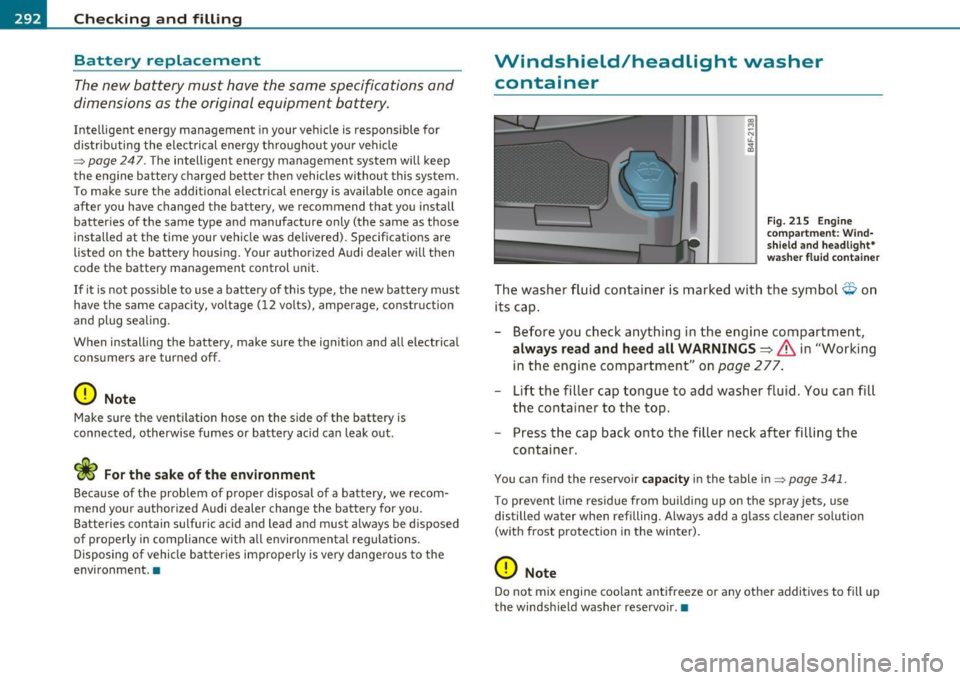
___ C_h_ e_c _k _i_n -=g :a,__ a_n_ d_ f_ i_ l _li _n _,g;._ __________________________________________ _
Battery replacement
The new battery must have the same specifications and
dimensions as the original equipment battery.
Inte lligent energy management in your veh icle is responsible for
dis trib uti ng the elect ric al ene rgy throughout yo ur vehi cle
::} page 247 . The intelligent energy management system will keep
t he e ngine battery charged be tter then vehicles withou t this system.
To make sure the additional e lectrical energy is available once again
after you have changed the ba tte ry, we recom mend that you in sta ll
batter ies of the same type and manufacture only (the same as those
installed at the t ime your vehicle was delivered). Specifications are
listed on the battery hous ing. Your author ized Audi dealer will then
code the battery management control unit .
If it is no t poss ible to use a ba tte ry of this type, the new battery m ust
have the same capacity, vo ltage (12 volts), amperage, construction
and plug sea ling.
When install ing the battery, make sure the ign it ion and a ll electrica l
cons umers are turned off .
0 Note
Make sure the venti lation hose on the side of the battery is
connec ted, othe rwise fumes or battery acid ca n leak out .
W For the sake of the environment
Because of the problem of proper disposal of a bat tery, w e recom
mend your authorized Audi dealer change the battery for you.
Batte ries contain sulfu ric acid and lead and mus t alway s be d ispose d
of properly in compliance with all environmental regulat ions.
Di sposing of vehicle b atteries imprope rly is very dange ro us to t he
environme nt.•
Windshield/headlight washer
container
Fi g. 215 En gine
compartm ent: Wind·
s hie ld and head light*
w as her flu id co ntainer
Th e washe r fluid contain er is mark ed with the symbol O on
its cap .
- Bef ore you check anything i n the engin e compartm ent,
always read and heed all WARNINGS~ & in "Working
in th e e ngine com partme nt" on
page 277 .
- Lift t he filler cap tongue to add washe r fluid. You can fill
the conta iner to the top.
- Press the cap bac k onto the filler neck af ter filling the
container .
You can find the reservoir capacity in the table in::} page 341 .
To preven t lime res idue from bui ldi ng up on t he spray jets, use
distilled water when refilling. Always add a glass cleane r so lution
(with frost protection in t he winter).
0 Note
Do not mix engine coo lant antifreeze or any othe r additives to fi ll up
the windsh ield washe r rese rvo ir .•